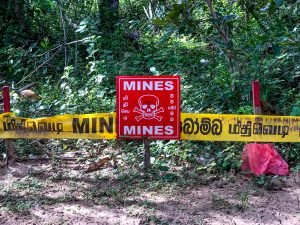Silva Raja, a coconut farmer, now 61, remembers the day he fled his home more than two decades ago. Just outside of Muhamalai, an hour south of the city of Jaffna, his house is surrounded by lush coconut trees. To the west are small fishing communities.
During Sri Lanka’s deadly civil war, which lasted 26 years in a protracted conflict, heavy shelling in Raja’s region forced people to flee by the thousands. In their place, thousands of anti-personnel mines were laid by both the Sri Lankan Army and the Tamil Tigers (LTTE). These minefields kept people from coming back even after short ceasefires, or immediately at the end of the war in late 2009.
The result in the northern region was mass displacement of most civilians in the hundreds of thousands by the end of 2009. The war also left more than 100,000 people dead. On January 20, newly inaugurated President Gotabaya Rajapaksa finally acknowledged for the first time that the 20,000 people who disappeared during the civil war are dead.
The latest data available says that since the 1980s, 22,193 people have died from landmines and other explosive remnants of war. UNICEF reported that from 2006 to 2009, one of the most intense periods of the war, accurate casualty information was difficult to access, likely meaning that many deaths were not reported.

Raja Silva, 61, a coconut farmer in front of his house near Muhamalai, Sri Lanka. Photo by Nicholas Muller.
Because of the war, Raja left to work in Saudi Arabia for 16 years, and watched from afar, waiting for the moment when he could return home. In early 2010, he and thousands of others displaced by the conflict slowly returned to their land to see what was left. The area around his house for many square kilometers was littered with landmines, and most of the coconut trees were cut down by the army, almost all the way to the coast. Other villages were permanently abandoned because of widespread landmine contamination.
Raja and the majority of people in communities across Sri Lanka’s north live off the coconut trees on their land or work in the fishing industry. Not having access to all of their land because of landmine contamination continues to stunt development and prevent a return to normalcy in the region. Raja points to the empty fields where coconut trees used to be.

Coconut trees have been cleared in many areas that have been or are being demined. The trees are a major source of income for people in the region. Photo by Nicholas Muller.
“The area used to be full of coconuts. Not anymore. It is still impossible to farm or cultivate (coconuts). It’s how we’ve always made a living here.”
A few years ago, he returned to live in his house full-time after the area around his house was finally cleared.
“I hope one day I can grow coconuts again. There’s still a long way to go until things are normal here,” Raja says.
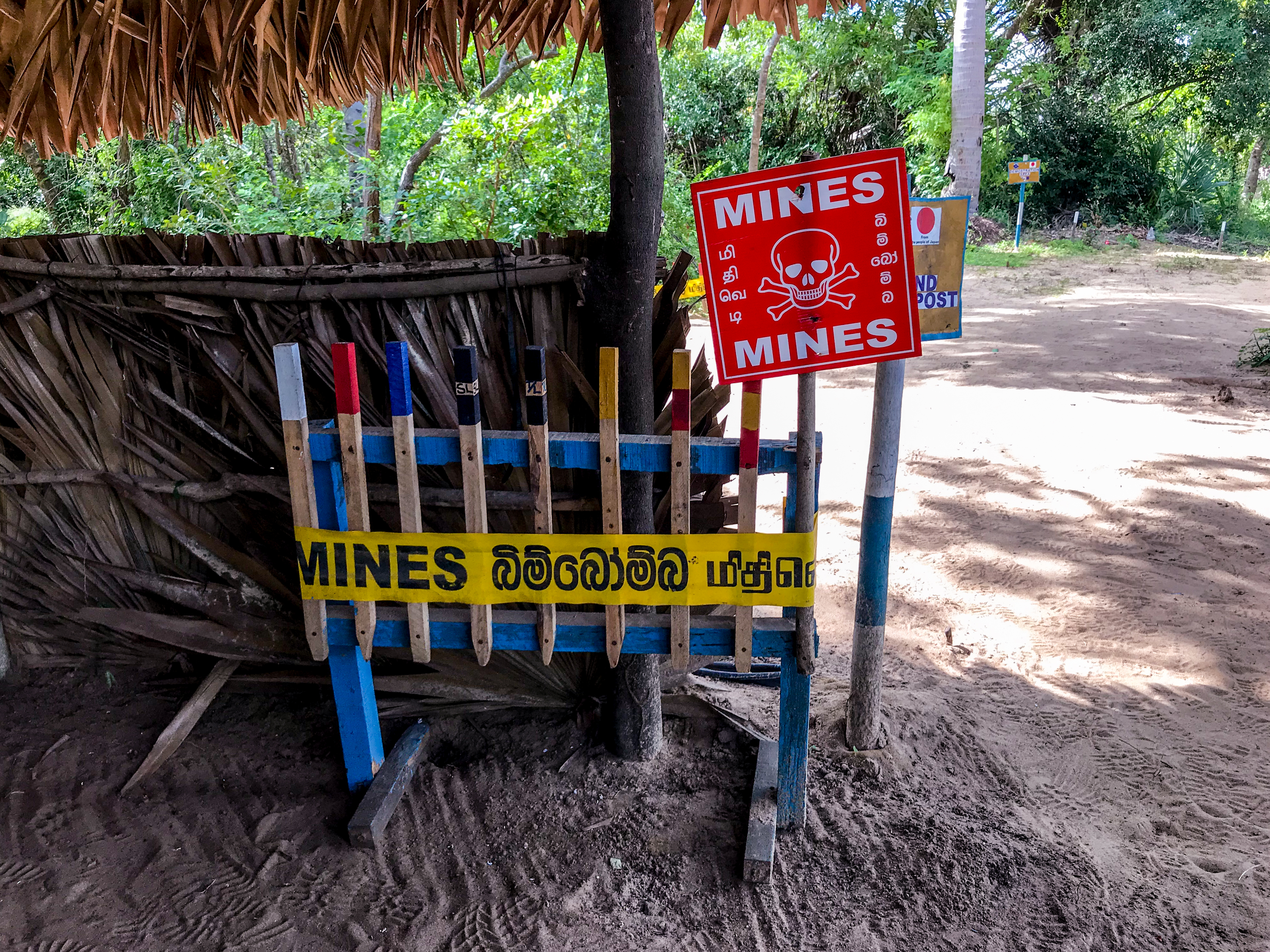
Delvon Assistance for Social Harmony (DASH) is a Sri Lankan non-profit demining NGO which has operated in Sri Lanka since 2010. Here are the markers they use to indicate if a field has been cleared (white) or if there are mines in the area (red). Photo by Nicholas Muller.
A Long Way to Go
The northern areas of Sri Lanka are still considered to be one of the most militarized regions anywhere in the world and have one of the heaviest concentrations of landmines. The mines blanket much of what would be farmland here, and continue to disproportionately affect civilians. According to the Landmine and Cluster Munition Monitor initiative, from 2010 to 2018, estimated contamination fell from 506 square kilometers to 25.8 square kilometers. However, the extent of mine contamination is still considered to be heavy.
According to MAG International, one of the two international demining organizations still on the ground in the country, information from the National Mine Action Center shows that the total remaining contaminated area in Sri Lanka still amounted to 23,306,478 square meters (23.3 square kilometers) in 2019.
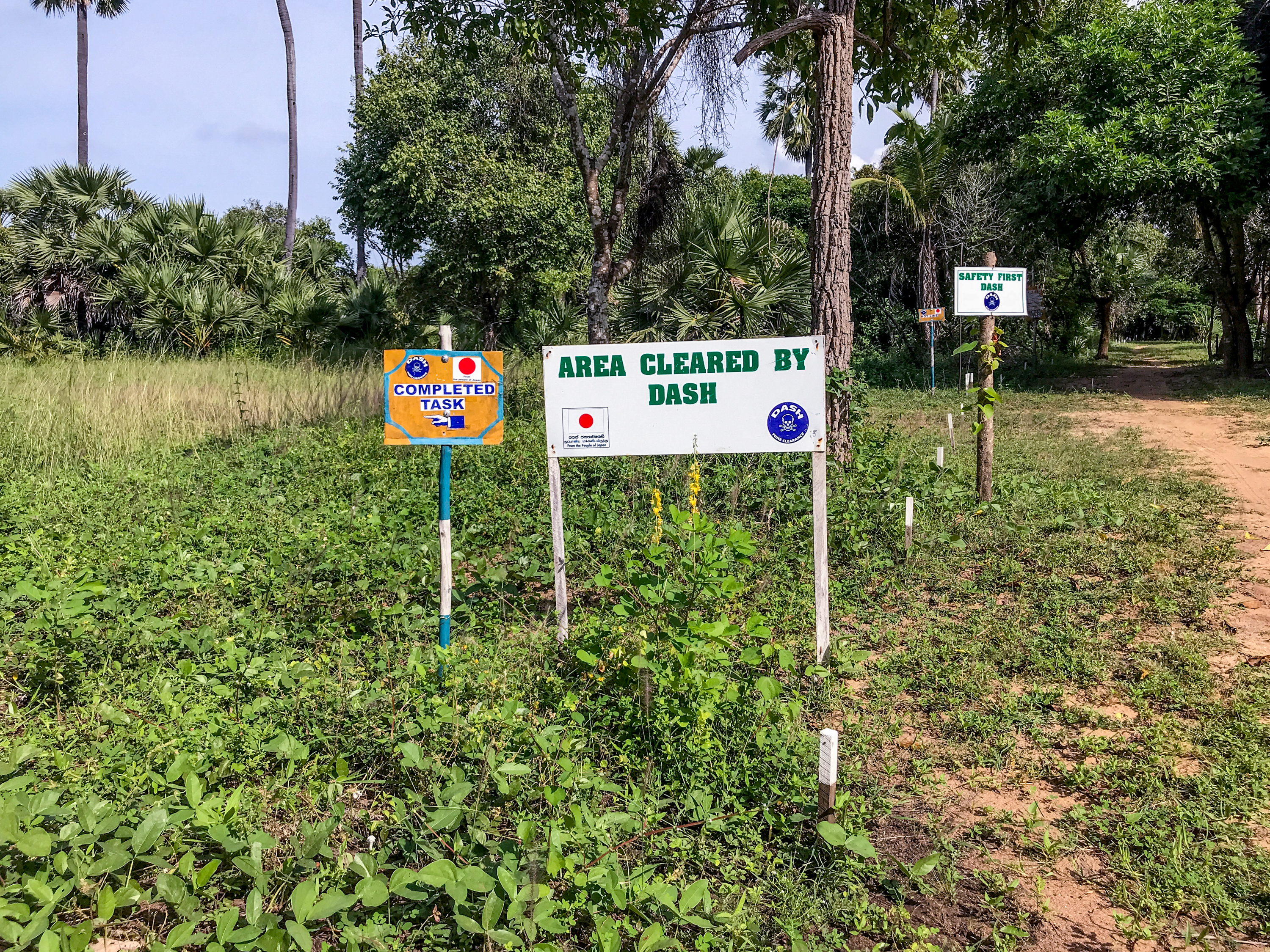
Corridors are set up leading to minefields that are still being cleared. Markers are used to indicate if a field has been cleared (white) or if there are mines in the area (red). Photo by Nicholas Muller.
As of January 2019, HALO Trust Sri Lanka, the largest demining operator in the country, had reportedly cleared 309,354 mines and unexploded ordinances (UXOs). When contacted multiple times for comment about its progress in 2019, HALO declined to provide a comment for this story.
MAG International is the second largest international operator in the country and is focusing its efforts in the northern provinces of Mannar, Vavuniya, Mullaitivu, and in the eastern provinces (Trincomalee) where a sizable amount of mines remain. MAG’s country director for Sri Lanka, Valentina Stivanello, said that in 2019, “the organization’s demining staff released [declared safe] approximately 1.25 million square meters of land, and removed 5,104 dangerous items,” meaning landmines, UXOs, and small arms and ammunition.
The organization does not have accurate information about the 2019 activities of other operators working in Sri Lanka. The National Mine Action Center, the operational body that executes the policies of the National Steering Committee for Mine Action and the focal point for coordinating all mine action activities on the ground, could not be reached for comment.
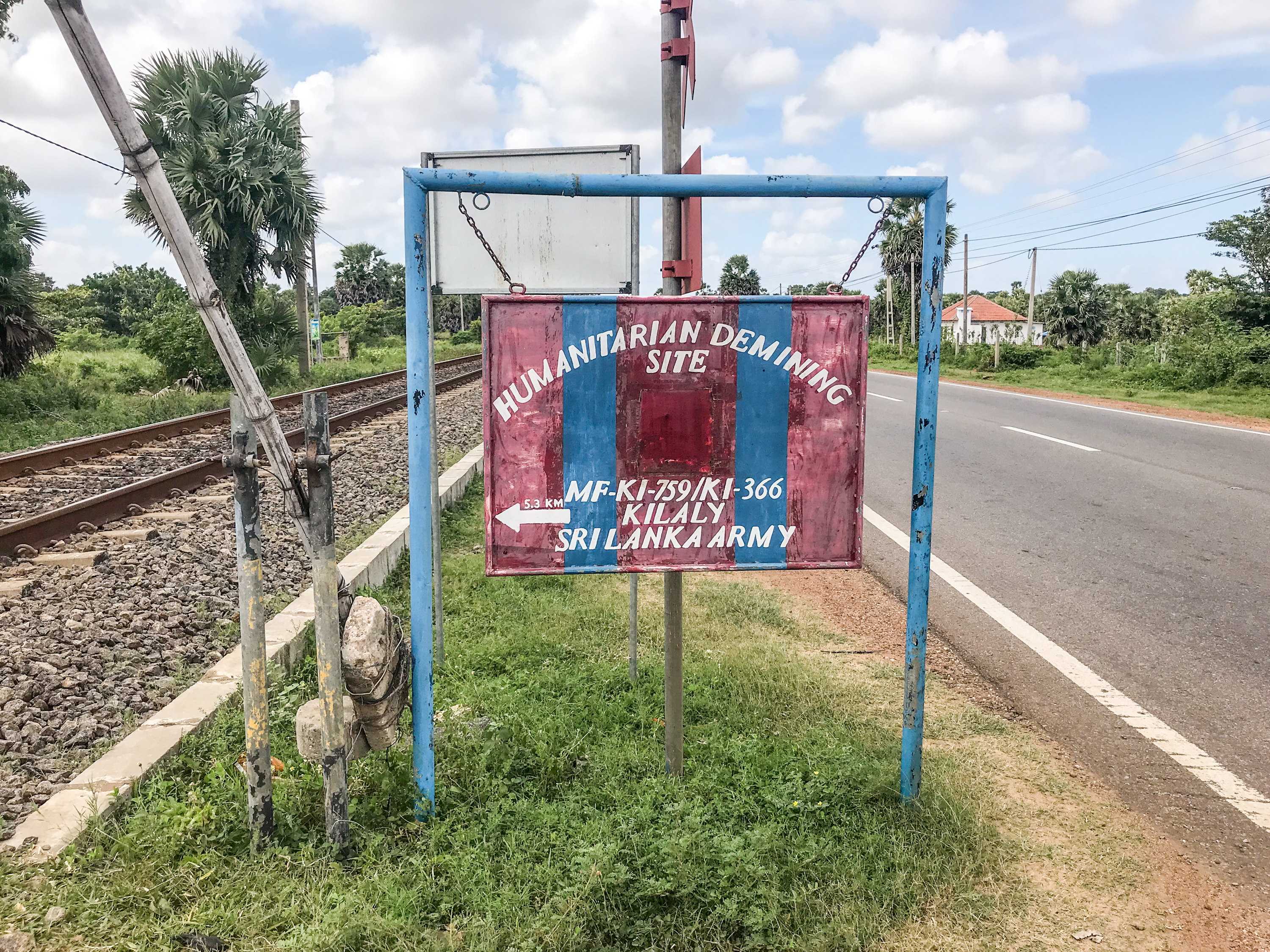
On each side of the the Jaffna-Kandy highway corridor, multiple minefields blanket the landscape. International and domestic demining organizations have worked for close to two decades to clear contaminated areas. Photo by Nicholas Muller.
Demining work is dangerous, expensive, time consuming, and incredibly complex. Hundreds of thousands of mines have already been cleared, in efforts largely funded by the United States, Germany, Japan, Norway, Australia, and the United Kingdom. Foreign funding still largely determines the extent to which demining organizations are able to do their work, and often falls short of what is needed to finish the job.
Although many of the minefields have been marked and identified, de-miners must go square by square in often grueling heat and dangerous conditions to continue the demining process.
Since the end of the conflict in 2009, MAG says it has declared over 35 million square meters of land safe in Sri Lanka, clearing over 42,000 mines and 14,800 other unexploded bombs.
Many of the deminers are Tamil women who survived the civil war. They work for the HALO Trust, MAG International, and domestic de-mining operators. A large number of de-miners have been directly affected by the civil war and anti-personnel landmines, or have had relatives maimed, killed, or still remain unaccounted for from the conflict.
Although these days most mines do not cause casualties, their toll on the civilian population living on the land and hoping to return to it is still high. Many are living very close to areas still highly contaminated with landmines or UXOs. This not only continues to pose an immediate threat to people’s lives, but it also inhibits the ability of countless communities across the region to build schools, farms, and infrastructure.
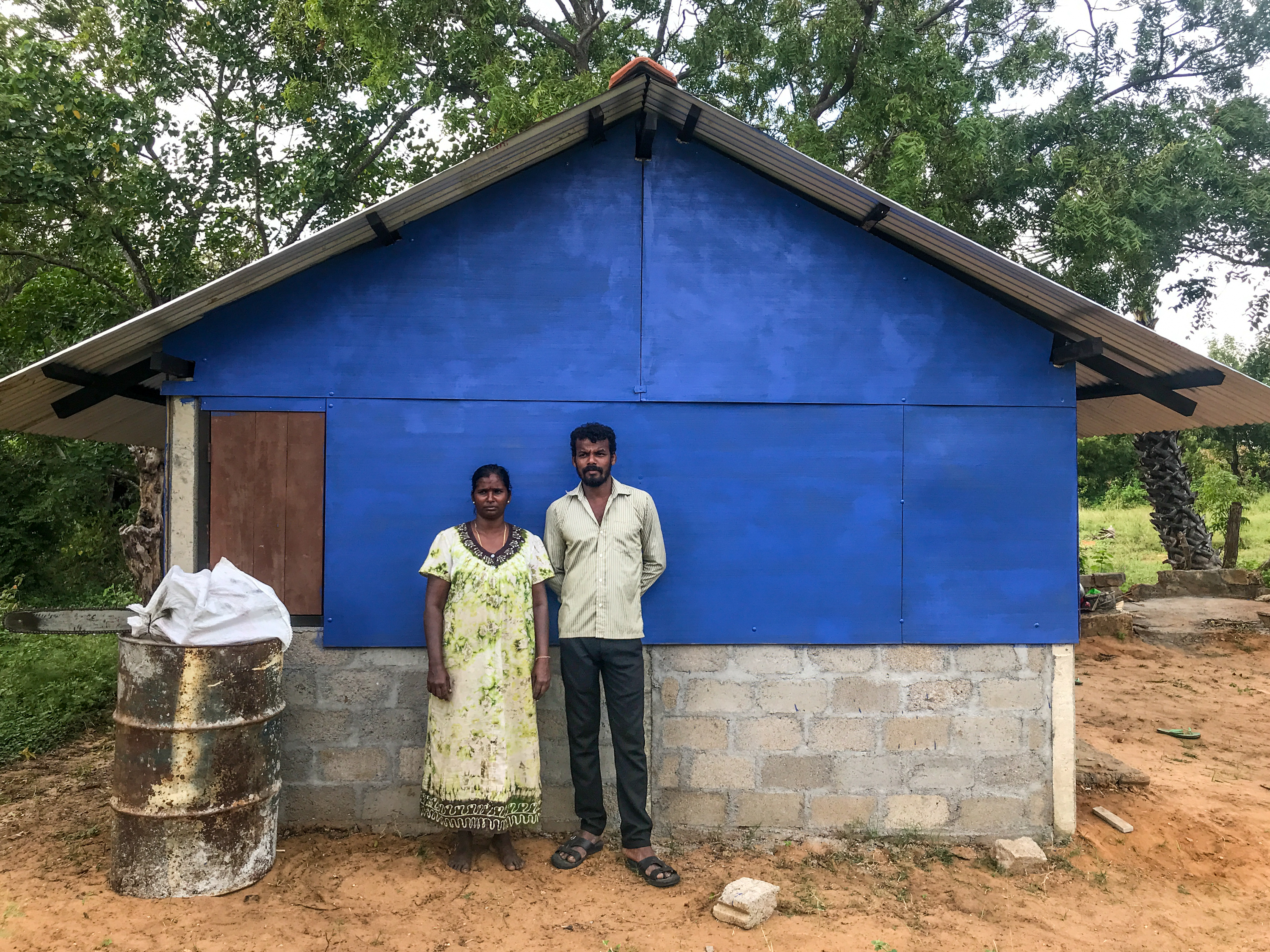
Ramis and Lakshmi Rajakopal, both 37, in front of the temporary shelter they have lived in for two years. Photo by Nicholas Muller.
Ramis Rajakopal, 37, lives that reality every day. Right behind the temporary shelter to which he moved with family two years ago is a minefield that HALO is currently demining. He lives with his wife, Lakshmi, and young daughter just meters away from two minefields. Ramis says his house was destroyed during the war by the LTTE when he was a teenager, 23 years ago, but he dreams of returning home.The skeleton of a former church sits directly next to his house, riddled with bullet holes, a daily reminder of the violence that happened here.
Ramis is now a day laborer in Jaffna and waits for the day the land around his home is “clean” and he can live there again with his family. Fifteen other families in the immediate area wait for the same, as do thousands of people across the north of Sri Lanka.
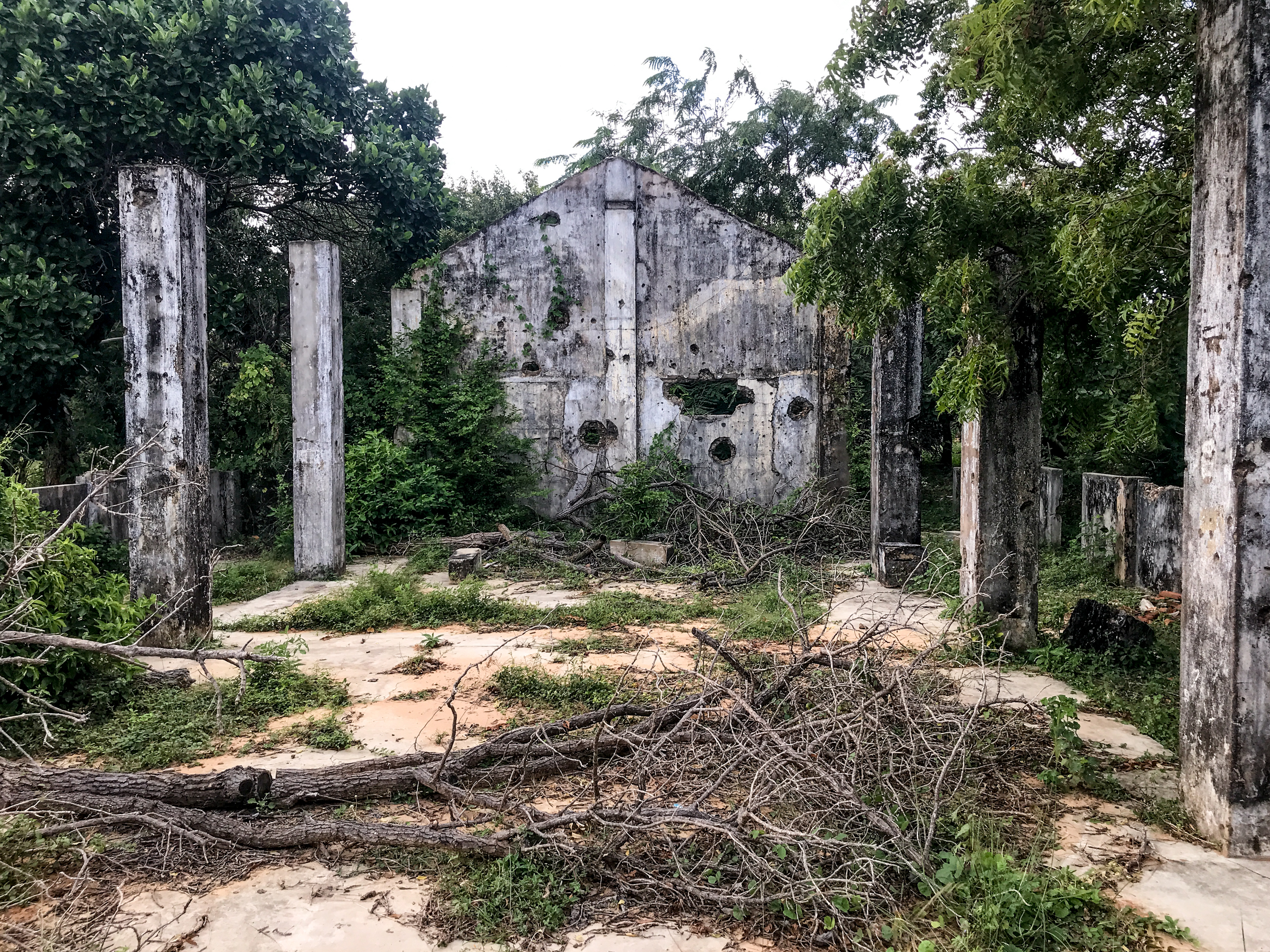
Remnants of a church next to an active minefield and the Rajakopal’s temporary shelter. They say 23 years ago the church was destroyed by the LTTE Tamil Tigers. Across the whole north, buildings, homes, palm trees,and abandoned cars can be seen with bullet holes from the civil war. Photo by Nicholas Muller.
According to MAG’s Stivanello:
Landmines continue to pose a threat to life and limb, preventing people from resettling on their land and restarting their livelihoods. As long as the mines are there the land cannot be used for anything productive. It cannot be farmed, no infrastructure such as roads, shops, schools or hospitals can be built, and this also has a significant economic impact on surrounding communities. On top of all this is the fear of knowing that landmines are near, that your children could go off the path and into danger, which is something people living in countries without landmines never have to think about.
It is estimated that 80 percent of those living in these communities are farmers or fishermen and rely directly on the land to survive. The dangerous situation generated by the linemines has created an even larger disparity between the north and Sri Lanka’s other regions, where development has been able to proceed and incomes have increased, especially in areas that have been recast as major tourist destinations. The north, however, sees very few foreign visitors and negative perceptions remain about the safety of the region.
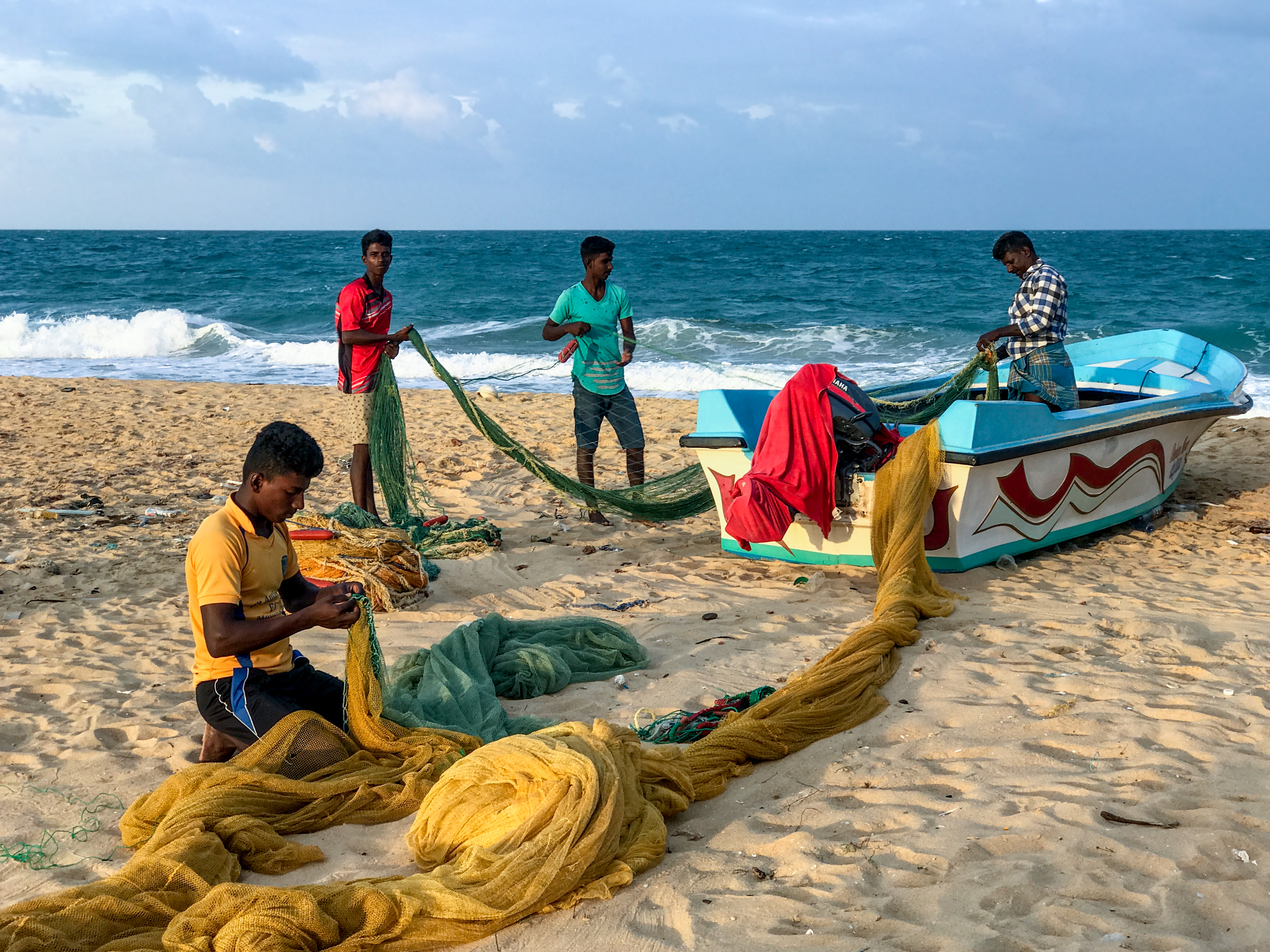
Fishermen unraveling their nets in the small fishing community in the northeast of Sri Lanka. Photo by Nicholas Muller.
Broken Promises and Renewed Fears
Sri Lanka’s former president, Maithripala Sirisena, was elected in 2015 in part on the basis of a pledge that he would investigate the actions of his predecessor, Mahinda Rajapaksa, who was in power for a decade. Rajapaksa has been accused of gross human rights violations, especially at the end of the war against the Tamil Tigers (LTTE).
Back in 2009, under the then-Defense Secretary Gotabaya Rajapaksa’s command, the LTTE rebels were cornered and surrounded by the Sri Lankan military in Kilinochchi, the former headquarters of the LTTE. As the forefront of conflict, especially at the end of the war, according to UN estimates, the number of civilians killed there is estimated to have been between 40,000 and 70,000.
During this time, scores of people disappeared, likely captured and killed by Sri Lankan army forces. The number according to human rights groups is at least 20,000. The UN accused both groups of major atrocities, especially in the end stages of the war. The government vehemently denied the accusations that they committed war crimes and cut off access of journalists, observers, and aid workers to the north in 2009. A decade later, they have not changed their position despite the uncovering of multiple mass graves in Mannar, and in other northern locations.
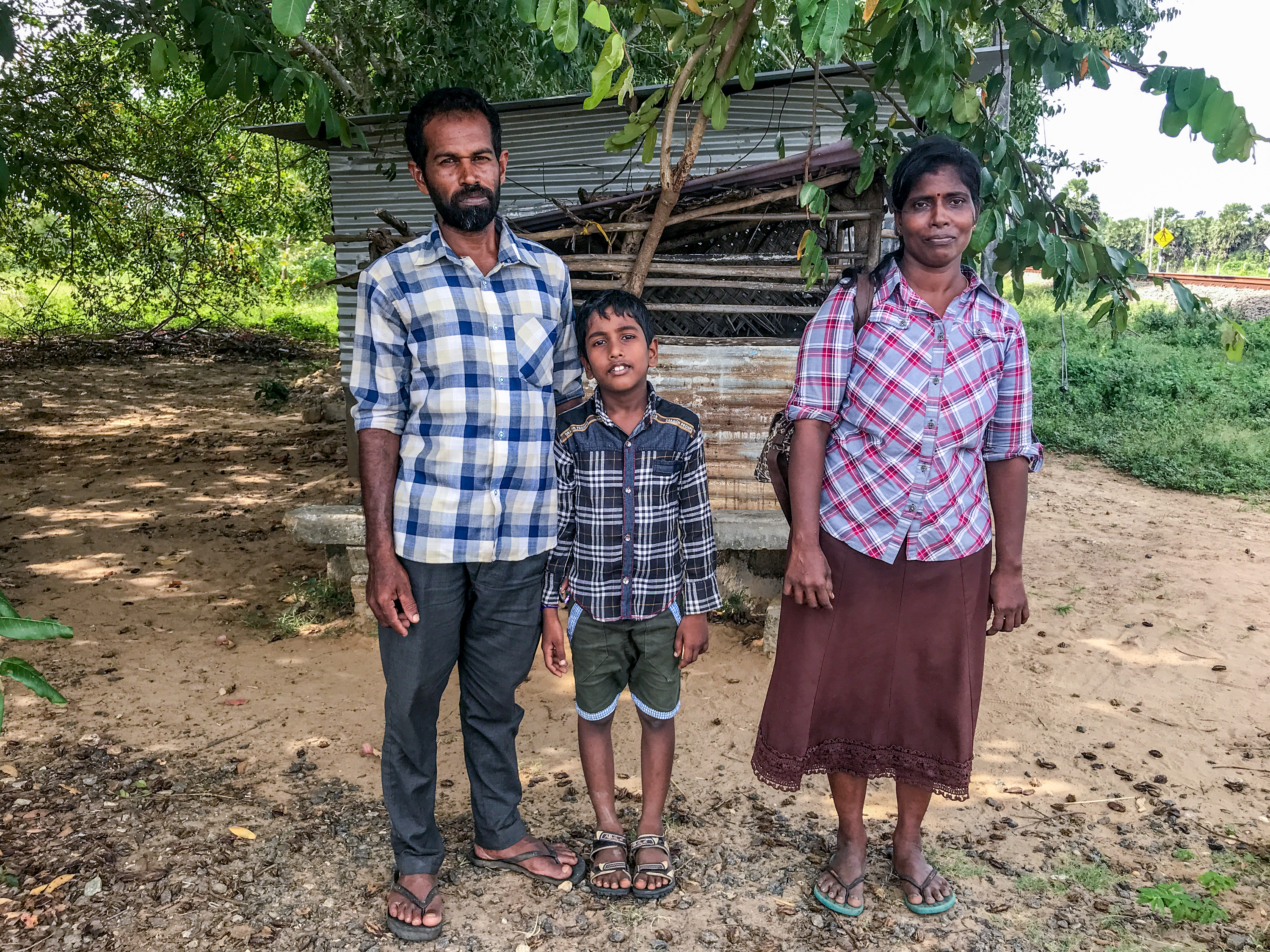
Baskara Devi, 41, and his family were resettled from their land during the clearing of mines near Muhamalai. Photo by Nicholas Muller.
The New York Times reported in December 2018 that over 2 million people in Sri Lanka suffer from mental health disorders, primarily in the northern part of the country where the majority of the 26-year conflict took place. Depression and post traumatic stress disorder (PTSD) are two of the major disorders still taking a high toll on survivors and children.
The Rajapaksas are back in power, with Gotabaya winning November’s presidential election after campaigning on themes of security and anti-terror. Such messaging was effective in the wake of the Easter terrorist attacks, which killed 290 people. But ethnic minorities in the country are worried about a return of the violence and crushing of oppositional voices that took place during the earlier Rajapaksa regime.
Sirisena’s response to the Easter attacks was to blame the investigations into civil war-era human rights abuses. He said at the time it “weakened the country’s security apparatus and left it vulnerable [to the attacks].”
“Many fear what the powerful Rajapaksa regime will do now that they have returned to power,” Raja says.
Many in the north interviewed for this story echoed that sentiment and see reconciliation as a distant pipedream now. The two brothers, Gotabaya and Mahinda, have been sworn in as president and prime minister, respectively.

A major war memorial at Elephant Pass, Sri Lanka. It served as an important strategic area during the civil war. Pictured here, a soldier tells stories of the conflict to Sinhalese visitors. Tamils call it a propaganda tool to rewrite the history of what transpired. Photo by Nicholas Muller.
The Sri Lankan Tamil minority is concentrated in the undeveloped north and eastern coast of the country. Tamils make up just over 11 percent of Sri Lanka’s population. Although predominantly Hindu, there are pockets of Tamils in the north who are Christian. More than 70 percent of Sri Lanka’s population is Buddhist, followed by smaller ethnic and religious groups: Hindus (12 percent), Muslims (10 percent), and Catholics (6 percent).
When the war ended, Raja returned, but many of his neighbors didn’t. Many families here are still trying to track down information about the whereabouts of their family members killed or disappeared during the war. A decade later, thousands are still searching for answers but are not optimistic if they will ever come.
“If progress wasn’t made under Sirisena, what should we expect under this regime, which labeled us terrorists? Nothing has happened to improve the situation and we don’t have any expectations things will improve under this administration. More people will leave,” says Raja.
A Global Landmine Problem
Sri Lanka is not the only Asian country battling to clear landmines and unexploded ordinances: Afghanistan, Cambodia, Myanmar, Thailand, and Laos also suffer from heavily mined areas. The Landmine and Cluster Munition Monitor initiative’s latest Landmine Monitor report notes that government forces in Myanmar, which has not signed on to the Mine Ban Treaty, are still using new anti-personnel mines. Non-state actors in Afghanistan, India, Myanmar, Nigeria, Pakistan, and Yemen have also used them in the past year. Sri Lanka is one of the most recent countries to join the Mine Ban treaty (it did so in 2017). There are several other states that are still not party to the Mine Ban Treaty, including China, Egypt, India, Israel, Pakistan, Russia, and the United States.
According to Landmine Monitor 2019, a report released in November, 6,897 people were killed or injured by landmines worldwide in 2018.

An active minefield being currently demined near Muhamalai. Photo by Nicholas Muller.
In 2018, international donors contributed $642.6 million to mine action in 43 states and three other areas, a decrease of $53.7 million (8 percent) compared with 2017. Much of the current international funding for demining is concentrated in five states: Iraq, Afghanistan, Syria, Croatia, and Laos – which together received the bulk of international funding, $351.2 million, or 55 percent of all international support in 2018. Without funding resources, most countries affected by landmines are unable to deal with the landmine situation on their own.
Sri Lanka’s government had a stated goal of becoming mine free by 2020, according to emailed comments by Stivanello: “Under Article 5 of the Mine Ban Treaty, Sri Lanka is required to destroy all anti-personnel mines in mined areas under its jurisdiction or control by not later than 1 June 2028. The current National Mine Action Strategy 2016-2020, re-launched in March 2019, set a bold vision for Sri Lanka to be mine free by 2020. The strategy will be revisited by the Sri Lankan Government in 2020.”
Nicholas Muller is an American photojournalist and writer.













